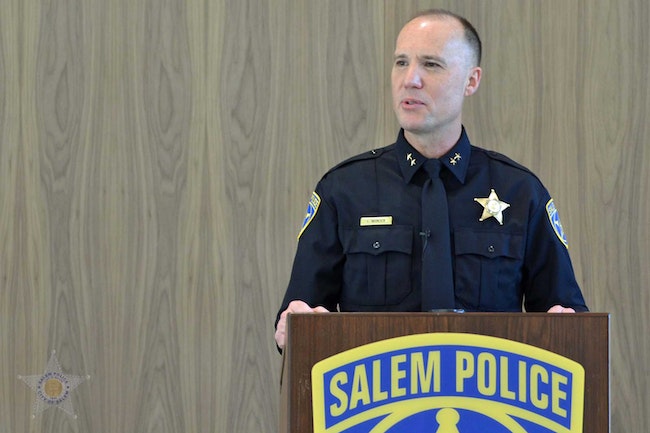
Police Chief Trevor Womack. (Courtesy/Salem Police Department)
Salem’s new police chief said the department’s ability to analyze data will be a top goal of the department moving forward. But Trevor Womack cautioned that other changes recommended in a draft assessment of the department released last week will take months if not years to come to fruition.
The assessment called out several areas where the Salem Police Department can improve, like creating a strategic policing plan, using its data to direct resources and building relationships with the community to improve trust in the department.
Salem City Council called for an audit of the department last summer following racial justice protests in which Salem police were accused of disparate treatment of Black Lives Matter protestors and armed right-wing groups like the Proud Boys.
In an interview with Salem Reporter on Tuesday, Womack said the agency is trying to shake the untrue perceptions that officers favorably treat right-wing groups that had begun to stick since protests first started in late May.
While Womack wasn’t in Salem when the incidents happened, he said he understands the allegations of bias to be untrue after speaking with officers internally.
At the time, former police chief Jerry Moore released a review of police handling of the protests, publicly stating Salem police didn’t side with an armed militia group that defended Glamour Salon over the summer. His review came after a video of a Salem police officer telling the armed group they needed to discreetly remain in the building or in their cars to avoid violating a city curfew gained national attention.
Womack said community accusations of police bias are an indication of broken trust. He went on to say that building trust within the community is equally as important as responding to calls for service.
“How do we as a city, as a community, come together with the police department and begin to design a process to increase legitimacy and deal with these perceptions. These perceptions are a symptom, and the actual problem is trust or lack or legitimacy. And that’s dangerous. It can’t be ignored by a police agency. It has real impacts,” Womack said.
But he said building trust within the community is a process that will take years.
“There’s not some box that we’re going to check to say that we’re doing trust building,” Womack said. “For me, it’s something that we need to grow more organically within the organization, so it fits for Salem PD and our community.”
Womack pointed to small steps the department has taken since he took on the role of police chief in December.
He publicly stated the department’s priorities when responding to protests in December, also condemning white supremacy and racism.
Womack said the department has added an additional internal affairs sergeant who’s responsible for investigating complaints of police misconduct. Previously there was only one sergeant assigned to that role, conducting 18 formal investigations last year and 119 informal inquiries.
He also added a community member to the interview panel for new hires.
“Again, these are little steps, but we’re not waiting. When we identify a priority need to move us forward, we’re taking action on that,” Womack said.
Community building
Right now, Womack said he is laying the groundwork for a coming together of line-level officers and community members with different perspectives.
To achieve that, he said he wants to identify the right staff internally and community members outside the organization to begin that work. He’s working to form a community advisory board with a cross section of the community that has Black, Indigenous and people of color represented.
“It becomes a sounding board for a good representation of your community to provide direct input on the daily operations of the police department,” he said. “But that takes time to build.”
Data
Womack said increasing the department’s analytical capacity will be a foundational goal as it creates a strategic plan.
One of the key findings in the assessment was that Salem police don’t regularly analyze their crime and calls for service data to make decisions about where, when and how to use resources.
“It’s not like the department’s not making any data driven decisions… There is a need to increase capacity, but I think when you first read the report the findings are so blunt that it almost seems like: ‘Wow, they don’t have any data. They’re not making any smart decisions.’ But that’s not the case,” Womack said.
He said the department has one crime analyst.
Treven Upkes, Salem police spokesman, said the analyst looks at repeat calls for service, most contacted locations and certain crime or call types. When there’s a particular issue, like a rash of shootings in the summer of 2019, the department will ask for a more specific analysis.
Womack recently formed a committee within the department to look at what sources of data the department has and building a management system around those to make data-driven decisions.
The Salem Police Department transitioned to a new records management system in November of 2019. The Willamette Valley Communications Center, which provides 911 dispatch for Marion, Polk and Lincoln counties, is updating its computer-aided dispatch system, Womack said.
“We still need systems to analyze it and human intelligence to make sense of it. I think that’s where that logjam is or that lack of capacity is,” he said.
At the end of that process, Womack said the department will become more transparent with the community and start sharing data publicly.
Strategic plan
Womack said the strategic planning phase will likely take six to eight months. He said ideally a plan would be in place by the start of 2022 but doesn’t want to rush the process if it takes more time than that.
“But we will create a strategic plan that will include a community voice, it will have overarching goals with specific objectives. It will have metrics and measurables attached to those so we can be transparent about measuring our success in holding ourselves accountable,” he said. “That plan will become the way we manage this department.”
He said everything mentioned in the audit will be incorporated into the strategic plan.
Womack said the process of creating the plan matters more to him than the outcome. He plans to seek community input during the process, which could include the community advisory board he’s considering.
Diversity
The assessment called out concerns about diversity within the Salem police force which is overwhelmingly white and male. During a September work session, Moore said there were 173 white officers, 15 Hispanic officers, one Black officer and one American Indian officer.
That’s an issue that plagues police departments across the country.
It gave as a recommendation developing “a formal recruiting and hiring program focused on increasing the diversity in the department. Collaborate with the City of Salem’s Human Resources Department, communities of color and specific organizations willing to assist the SPD recruit candidates of color.”
The assessment said it is difficult to encourage people of color to join the police force when the officers seen patrolling the streets and those engaged in recruiting efforts do not look like them.
Womack said short term fixes to that issue are difficult and will take years of building relationships in the community and increase interest from communities of color to increase the number of people who apply.
He didn’t sugarcoat the timeline. He said it will take a decade to bear the fruits of the labor the department does to build relationships. But he said he’s committed to doing that work now.
Interacting with those in mental health crisis
Womack said he would be in favor of a CAHOOTS-style model that had a crisis worker and medic responding to calls for those in mental health crisis rather than police. Womack said he’s not opposed to sharing funding with such a program, (Eugene’s model is funded through the police budget) but wants it to be well designed so that officers don’t end up responding to calls anyway.
“I want to make sure we design this in the right way to where it actually works and that it truly does free us up from those calls so we can move on to other things which are much more important,” he said.
Womack said he’s heard the call for officers to participate in crisis intervention training to better respond to people experiencing behavioral and mental health crisis.
Because of Covid and protests, Womack said the department has cut training and the training that does happen occurs during overtime because of staffing levels.
“We don’t train our staff on duty anymore. We make them come in on their off time to get the basic level training they need. So, I’d love to do more (crisis intervention) training and we will figure it out. But practically speaking, how? Honestly at some point there’s not enough time left in the day to add training either,” he said.
Womack said the department doesn’t have any full-time trainers. Officers are assigned as a side duty to lead training on how to de-escalate or use firearms.
He said that’s common in other departments but it’s not a best practice.
Womack said it’s not that the department is resistant to some of the recommendations, but capacity is an issue.
“We’ve really got to pace ourselves. And hopefully the community understands that so we’re going to have to communicate that as best as possible that any delay in some of these things there’s a reason behind it. It’s not because we’re not committed to implementing them,” he said.
Have a tip? Contact reporter Saphara Harrell at 503-549-6250, [email protected].
Salem Reporter counts on community support to fund vital local journalism. You can help us do more.
SUBSCRIBE: A monthly digital subscription starts at $5 a month.
GIFT: Give someone you know a subscription.
ONE-TIME PAYMENT: Contribute, knowing your support goes towards more local journalism you can trust.









